
The Cecil H. Green Library is the main library on the Stanford University campus and is part of the SUL system. It is named for Cecil H. Green.

The Jasper Ridge Biological Preserve is a 483 hectares nature preserve and biological field station formally established as a reserve in 1973. The biological preserve is owned by Stanford University, and is part of the Stanford School of Humanities and Sciences. It is located at 37.408°N 122.2275°W south of Sand Hill Road and west of Interstate 280 in Portola Valley, San Mateo County, California. It is used by students, researchers, and docents to conduct biology research, and teach the community about the importance of that research. The preserve encompasses Jasper Ridge and Searsville Lake and the upper reaches of San Francisquito Creek, along with the latter's Corte Madera Creek and Bear Creek tributaries.

Leonard Roscoe Tanner is a retired American tennis player, who turned professional in 1972 and reached a career-high singles ranking of world No. 4 on July 30, 1979.
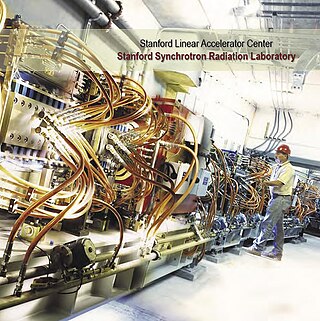
The Stanford Synchrotron Radiation Lightsource, a division of SLAC National Accelerator Laboratory, is operated by Stanford University for the Department of Energy. SSRL is a National User Facility which provides synchrotron radiation, a name given to electromagnetic radiation in the x-ray, ultraviolet, visible and infrared realms produced by electrons circulating in a storage ring at nearly the speed of light. The extremely bright light that is produced can be used to investigate various forms of matter ranging from objects of atomic and molecular size to man-made materials with unusual properties. The obtained information and knowledge is of great value to society, with impact in areas such as the environment, future technologies, health, biology, basic research, and education.

The Stanford University Arboretum is an arboretum located on the grounds of Stanford University in Stanford, California. It is open to the public daily without charge.

Arastradero Preserve, officially known as Enid W. Pearson–Arastradero Preserve, is a 622 acres nature preserve that protects most of the Arastradero Creek watershed, including its ephemeral Mayfly Creek tributary. It also includes the upper reach of the Felt Creek tributary to Stanford's Felt Reservoir. The preserve is owned and operated by the City of Palo Alto, California. The main parking lot hosts an interpretive center and is located at 1530 Arastradero Road.
The Center for Advanced Study in the Behavioral Sciences (CASBS) is an interdisciplinary research lab at Stanford University that offers a residential postdoctoral fellowship program for scientists and scholars studying "the five core social and behavioral disciplines of anthropology, economics, political science, psychology, and sociology".
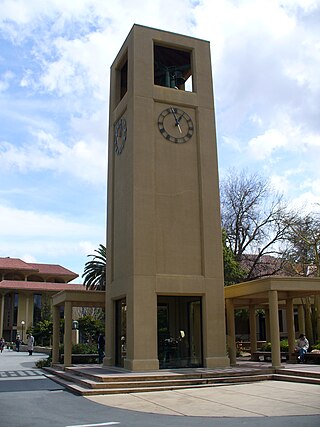
The Stanford Clock Tower with its attached, colonnaded pergola is located at the so-called “Circle of Death” at the corner of Escondido and Lasuen Malls on the campus of Stanford University. It was built in 1983 by a donation from trustee William Kimball.
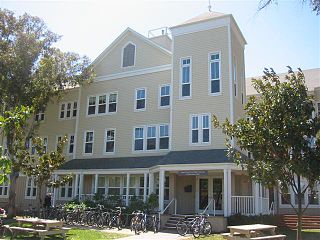
The Haas Center for Public Service, formerly the Stanford Public Service Center, is the public service center on the campus of Stanford University in Stanford, California.

The Gates Computer Science Building, or Gates building for short, is an L-shaped building that houses the Computer Science Department as well as the Computer Systems Laboratory at 353 Jane Stanford Way, Stanford University, California. Construction on the building began in 1994 and was completed in 1996 at a cost of $36 million. It was named after Microsoft founder Bill Gates, who donated $6 million for the building's construction.

Dedicated on October 21, 1993, the Cecil H. and Ida M. Green Earth Sciences Research Building at Stanford University houses classrooms, offices, and laboratories for research in the field of earth sciences. The building's extended basement contains the sunken Kresge Plaza, in which rock sculptures are designed to look like a miniature version of local geologic faults. It is named for Cecil Green, who co-founded Texas Instruments in 1951 with Erik Jonsson and Eugene McDermott.

Braun Music Center, known colloquially as Braun, is a music education building at Stanford University in California. Opening its doors in 1984, Braun serves as both the epicenter for music at Stanford, as well as a link between Stanford's main residential and activities centers. As the main building for the Department of Music, Braun is the venue for the department's concerts and recitals and offers rehearsal studios and practice facilities as well as classrooms and offices.

Memorial Hall, was built in 1937 to commemorate those students and faculty from Stanford University who died in World War I. Designed by Arthur Brown, Jr. in conjunction with Bakewell and Weihe, construction of the building was funded primarily through student contributions.

The Fire Truck House, built by Charles Hodges in 1904, served as Stanford University's firehouse until the early 1970s, when the current firehouse was built on Serra Street. It was staffed by a mix of students and professional firefighters. The students received room, board, and a stipend. A few later made firefighting a career, including William R. Bamattre, Chief of the Los Angeles City Fire Department from 1996 to 2007, and Nick Marinaro, Chief of Palo Alto Fire Department from 2004 to 2010.

Recreation Park was the name applied to several former baseball parks in San Francisco, California in the late 19th century and early 20th century.
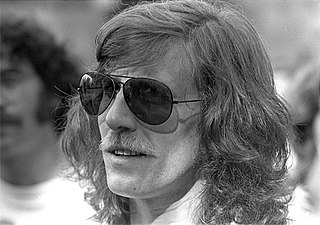
The Laurence Frost Amphitheater, commonly known as Frost Amphitheater, is a prominent amphitheater at Stanford University. It first opened in 1937 and was the site of commencement ceremonies for the university from 1938 until 1984. It can hold about 8,000 people.

Oyster Bay Regional Shoreline is a park in San Leandro, California, part of the East Bay Regional Park District (EBRPD). It is located along the eastern shore of San Francisco Bay directly to the south of Oakland International Airport. The property was originally used as a landfill for 37 years, until it was filled to capacity in 1977, when it was capped with a clay cover. EBRPD bought the property in 1980, intending to use it as a park.

The Keystone, also known as Keystone Berkeley, was a small music club at 2119 University Avenue in Berkeley, California, which operated in the 1970s and 1980s. Numerous nationally known groups performed there, including Tom Petty and the Heartbreakers, Ray Charles, Talking Heads, The Ramones, Metallica and B.B King, Blondie, and Greg Kihn among many others and the club was a regular venue for the Jerry Garcia Band. Keystone Berkeley, run by Freddie Herrera and Bobby Corona, was linked to The Stone and Keystone Palo Alto.

The Lathrop Library is one of several libraries at Stanford University in California. It is the current undergraduate library and houses the East Asia Library. Part of the Stanford University Libraries system, it opened on September 15, 2014 and houses collections and services formerly located in J. Henry Meyer Memorial Library, which was demolished in 2015. The library is located in a renovated building formerly occupied by the Stanford Graduate School of Business.
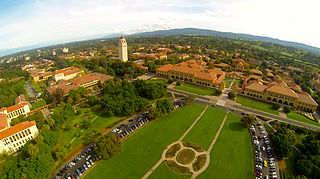
The Oval is an oval-shaped sunken lawn on the Stanford University campus in Stanford, California, United States.



















